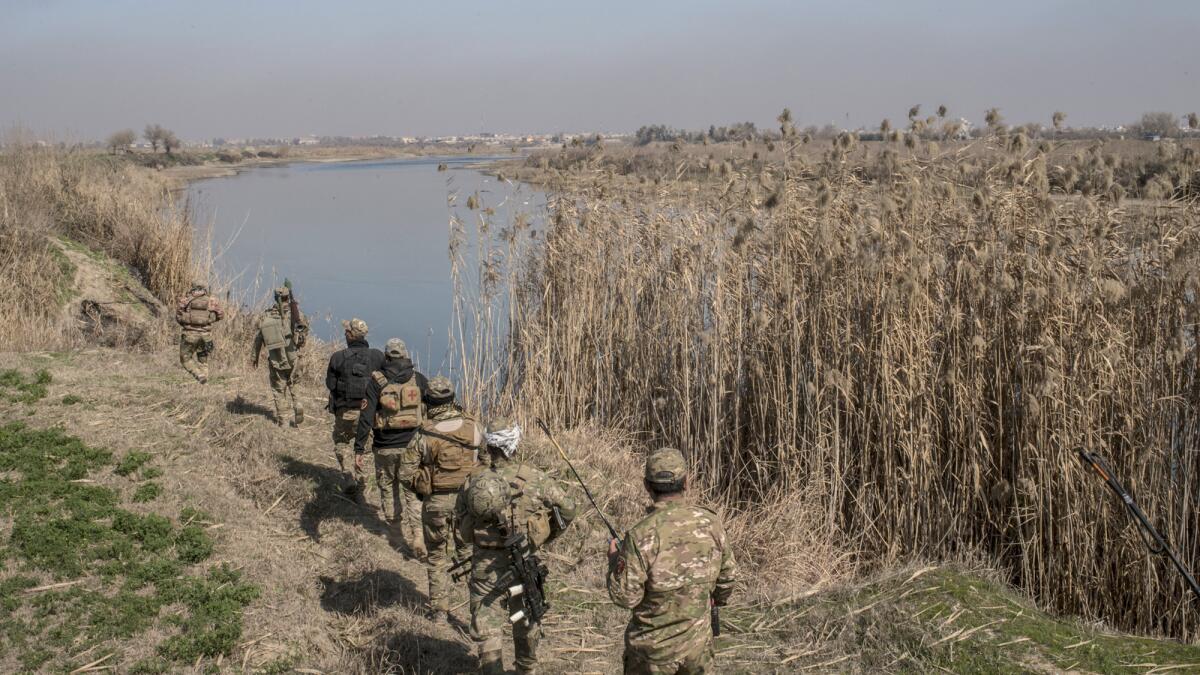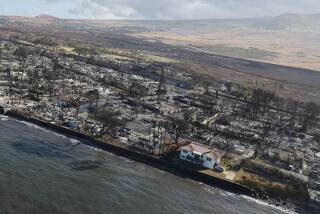Iraqi forces push into western Mosul in fight against Islamic State extremists

Reporting from Ghazlani Military Base, Iraq — Lt. Col. Riyadh Atshaan, his ginger mustache glinting in the afternoon sun, adopted an avuncular tone as he relayed his orders into the walkie-talkie.
“Don’t clump together in groups. Wear your helmets and bulletproof vests. Keep your head down,” he said.
His men began to unload their rifles and blankets, settling in for their night-long vigil near the northern rim of this sprawling military base.
“And remember, do not shoot indiscriminately. For the battle is long, and the ammunition is little.”
Atshaan had reason to worry. Less than half a mile away were Islamic State extremists taking cover in the industrial buildings that line the southern edge of Mosul’s west bank, the group’s last major bastion in the country.
Iraqi security forces backed by a U.S.-led international coalition had ramped up the pressure in the city’s south and southwestern areas Friday, the sixth day in a rebooted campaign to push the militants out of Mosul.
Friday marked the first time the Iraqi military had entered western Mosul since mid-2014, when Islamic State blitzed through the city even as tens of thousands of troops threw down their weapons and ran for their lives.
Units from the Emergency Response Division, an elite branch of Iraq’s federal police force, moved out of Mosul’s airport, which had been captured a day earlier, and entered the city’s Jawsaq and Tayaraan neighborhoods, according to a statement on Thursday to Lt. Gen. Abdul-Amir Rasheed Yar Allah, the operation’s commander.

Times special correspondent Nabih Bulos reports from Ghazlani military base south of Mosul where troops are poised to breach the city.
From the southwest, a second prong composed of U.S.-trained troops from the Counter-Terrorist Service overran the suburb of Tal Al-Rumman, wresting control of more than half of the Maamoun neighborhood, Yar Allah said.
Iraqi helicopters joined the attack as well, opening with heavy machine guns and rockets while artillery and high-explosive missiles by coalition warplanes kicked up blooms of explosions that could be seen for miles.
Iraqi Prime Minister Haidar Abadi congratulated troops in a statement for their “dazzling victories,” but insisted they exert maximum effort “to save civilians and protect them and provide safe corridors” for their exit.
Western Mosul, a densely populated part of the city, is estimated to have from 750,000-800,000 people.
In October, the government, in cooperation with the coalition, launched a large-scale campaign to claw back Mosul from Islamic State. Officials in January said troops had secured control over the eastern half of the city but halted their offensive at the banks of the Tigris River, which bisects the city. They restarted their offensive for the western bank more than three weeks later.
Mosul, once Iraq’s second largest city, in 2014 became the de facto capital of Islamic State’s rapidly expanding caliphate. At its height it comprised more than 30,000 square miles of territory, according to a report by IHS Conflict Monitor, and had a population of some 10 million.
Over the last year, the Iraqi government has reversed most of Islamic State’s territorial gains in the country. Despite the setbacks, the group has nevertheless continued its long-standing car bomb campaign against Shiite-dominated areas, especially in the capital, Baghdad.
Islamic State espouses a harsh interpretation of Sunni Islam that counts Shiites as infidels who must be killed.
Many fear that even if the group is ousted from major urban centers, it could melt into the countryside or cross the border into Syria, where the government is fighting its own battle against opposition rebels as well as Islamic State.
There it can take advantage of the chaos to regroup and strike again, much as it did in 2014.
On Friday, Iraqi F-16 airplanes conducted airstrikes on Islamic State targets in Syria for the first time.
In his statement, Abadi said, “We are determined to pursue terrorism … in any land where it is found.”
“The heroes of the sky conducted the operation to respond to the terrorists with dazzling success,” he said.
Islamic State has carried out devastating attacks in Syria, where on Friday more than 60 people were reported killed in at least one car bombing in the village of Sousian, near the city of Al Bab. The attack came a day after officials said control of the city had been taken from the extremist group by Turkish and Syrian opposition forces.
In the Ghazlani base, a military complex that had been pummeled by fighting and airstrikes into a jumble of jagged concrete and the mangled remains of Hesco barriers, Atshaan directed a Humvee to deploy near a berm facing Mosul’s Wadi Hajar neighborhood.
“There’s a sniper there, sir. He’ll shoot anything that moves,” warned one soldier. As if on cue, bullets whined overhead. The gunner on top of a nearby Humvee responded with a volley of fire aimed at the crumbling husk of a three-story building.
Atshaan’s second in command, Capt. Ali Assadi, consulted a GPS map of the Ghazlani base on his tablet as he assigned a place for his cadres.
“Daesh has set up defensive trenches in this area here,” he said, using an Arabic acronym for Islamic State as he pointed to an area just beyond Ghazlani’s perimeter. “Look how close they are.”
Islamic State is thought to have set up a network of tunnels and barriers in an effort to both avoid detection and frustrate security forces’ attempts to flush them out of their enclave.
From the battles in the open desert and rural villages of the past week to the bare-knuckled urban warfare of western Mosul, the jihadists have put up a fierce resistance. Yar Allah said more than 20 car bombs left behind by extremist fighters had been destroyed on Friday by security forces.
Not far from where a mortar shell had fallen, a trio of policemen sat behind a toppled concrete slab, cracking jokes as they ate lunch out of foam containers full of rice and a stew called marag. A fearsome pack of flies buzzed nearby.
“We’re fighting two wars here: One against Daesh, one against the flies,” said Adnan Muhsen, a young policeman with a ready grin.
He pointed to his lunch companions, police officers Ali Karim Shannon and Ali Taee.
“Look at us here,” he said, his voice turning earnest for a moment. “We’re Sunnis, Shiites, it doesn’t matter. We’re all here to fight Daesh.”
A small distance back from where the police had bunkered, the CTS battalions that would storm Wadi Hajar in the next hours seemed almost bored as they waited for night to fall.
Some slept in the shadow of their Humvees; others hunted for unused power outlets to charge their smartphones; one even took out a small arghileh, a water pipe, to relax.
To the side, overlooking a verdant valley full of burnt carcasses of tanks and armored vehicles, a CTS medic, Sayf Kuhn, sat in the cab of his ambulance in an attempt to avoid the flies.
“Why do these people come over here? What do they want?” he asked after recounting a story about a Russian Islamic State fighter his friend had encountered. “Man, I’m from Baghdad, and even I get bored of this country.”
Bulos is a special correspondent.
ALSO
U.S.-backed Iraqi forces recapture Mosul airport and military base
Kansas shooting shocks an Indian city where ‘every other house’ has someone in America
More to Read
Sign up for Essential California
The most important California stories and recommendations in your inbox every morning.
You may occasionally receive promotional content from the Los Angeles Times.











